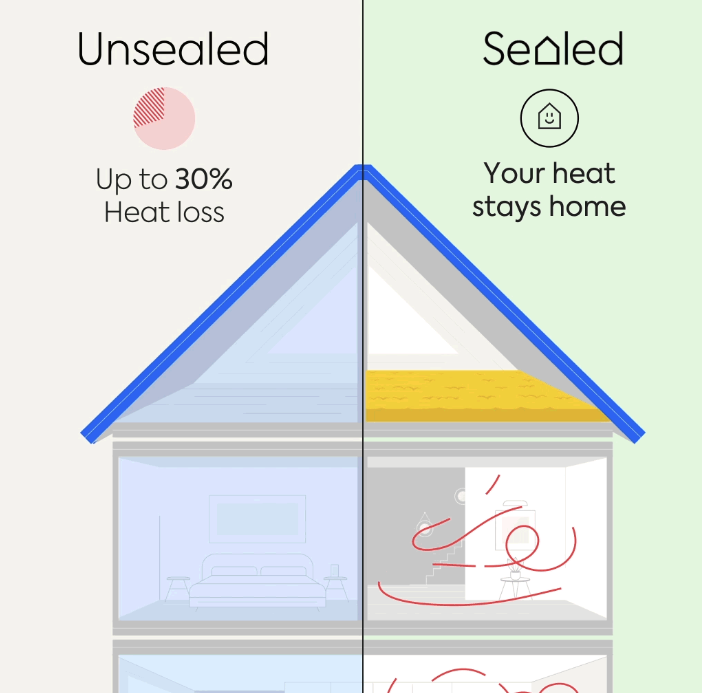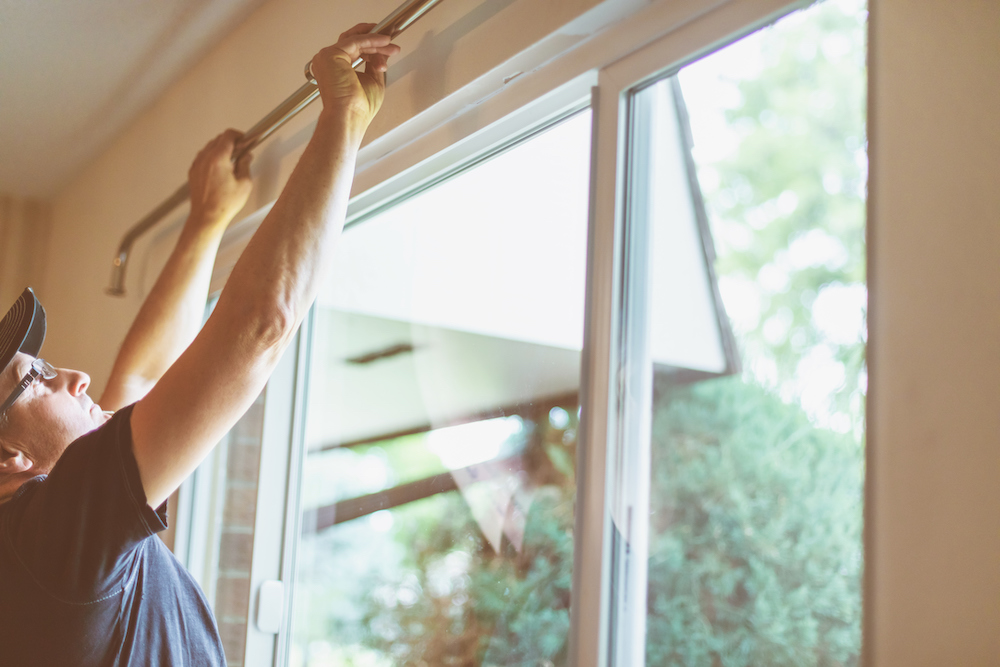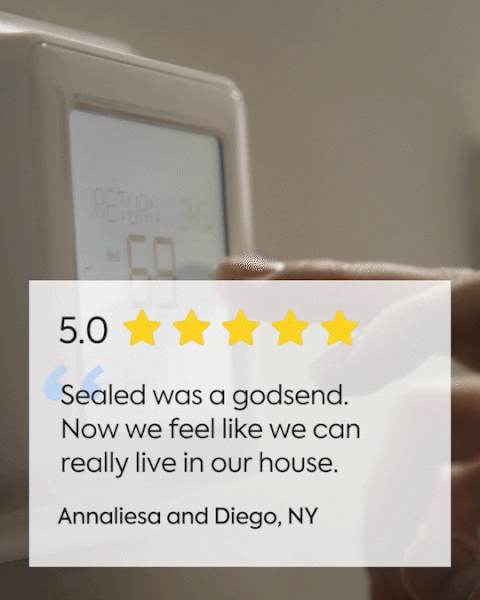Discover why and how insulated curtains can work as temporary window insulation in this guide.
If you’re wondering if thermal curtains are worth the investment, chances are you’re on a mission to make your house more comfortable or save energy (or both!).
You’ve landed in a good spot to find out if thermal curtains really work, but it’s important for you to know at the get-go that installing new thermal-insulated window treatments is a bandage solution to a much bigger problem.
This guide will help you determine if thermal curtains are the right choice for your home or if other whole-home weatherization upgrades are a better solution to make your home feel amazing year round.
And if you work with us (hi, we’re Sealed!), you can get these home-comfort upgrades—with an energy-savings guarantee—at no upfront cost if your home qualifies. Tap here to learn how.
Let’s get started by answering some basic questions about thermal curtains.
Table of contents
- What are thermal curtains?
- How do thermal curtains work?
- What are thermal curtains made of?
- Do thermal curtains save energy?
- Are thermal curtains worth the cost?
- What are the pros and cons of installing thermal curtains?
- What are the best thermal curtains?
- How can I make my own DIY thermal curtains?
- What are some alternatives to using thermal curtains?
- How can I fix window drafts permanently?
- Thermal curtain FAQs
What are thermal curtains?
Like most types of curtains, thermal curtains are fabric panels that hang on curtain rods. But thermal curtains are specifically designed to insulate your windows—keeping warm air out in the summer months and cold air out in the winter months.
They can also serve as blackout curtains to block light (which is super handy for east-facing bedroom windows that get the bright morning sun or rooms that contain energetic toddlers!).
And just because thermal curtains are utilitarian doesn’t mean they have to look that way. Many retailers (like Amazon or Deconovo) sell trendy thermal grommet curtains in a variety of textures, fun colors, and patterns to spice up your home decor. It’s nice to know you don’t have to sacrifice style, but how do thermal curtains work?
Good question…
How do thermal curtains work?
Ever bundle up on a cold day? Layers of winter clothing—think: shirt, sweater, coat—work together to trap in your body heat and protect you from the weather so you can be comfy and cozy while lobbing snowballs with the kiddos. That’s kinda how thermal curtains work, too.
To make a thermal curtain panel, multiple layers of fabric, including heavy insulating material, are sewn together. These thick layers of material trap air leaks behind the curtain, creating a thermal boundary between the outside air and your indoor living space.
(Of course, stopping the air leaks themselves is a better long-term solution. But in the short term, thermal curtains do a decent job.)
Technically, thermal curtains serve as moveable insulation.
If you know anything about insulation, you know R-value is really important. R-value is a measure of thermal resistance or the ability to create a thermal boundary between the inside of your home and the outside. Basically, R-value indicates the level of protection against heat transfer inside and outside your home.
For perspective, let’s compare R-values.
- Batts of insulation: R-value of 3.14 per inch of thickness (1)
- An insulated wall: R-value of 12 to 19 (2)
- A double-pane window: R-value of 2 (3)
A double-pane window has an R-value of only 2? That makes it easier to see why you might want to add an extra layer of thermal protection over your windows, especially when you consider that about 76% of sunlight that falls on a double-pane window becomes heat inside your home (4).
But do they really help save energy? Let’s find out.
I contacted Sealed for an energy evaluation…. The process was quick and easy.… Although you don’t see the work, you can feel the difference in the home immediately. I am so glad we did the work and used Sealed.
Karin M., Sealed customer
Do thermal curtains save energy?
If your windows are drafty in the winter and blasting heat in the summer, you might suspect that your home’s energy use is being impacted. You’d be right.
Windows are responsible for approximately 25–30% of your house’s heating and cooling costs (5), so your utility bills definitely take a hit when your heater and air conditioner is overcompensating for your windows.
But adding thermal curtains will not automatically reduce your energy bills by 25–30% like some window companies and window-covering makers may claim.
Here’s why. There’s a common saying in the home performance industry: “Your worst wall is still better than your best window.”
Basically, that means that even your worst, most poorly-insulated wall is going to do a better job of creating a solid thermal boundary for your house than the most energy-efficient window.
So while adding thick fabric curtains to your windows will somewhat help with energy savings, estimating the exact reduction in energy costs from installing thermal curtains is difficult to do.
The better option is to stop the unwanted air from getting through your windows in the first place. And that starts with understanding how it’s getting in. Watch the quick video below to learn more.
85% of single-family homes were built before 2000, when energy-efficient houses were not at all common.
Statista
How Cold and Hot Air Gets Through Your Windows
Many homeowners are surprised to discover that they still have excessive energy waste—even after an expensive window upgrade.
Why does that happen? The truth is: Air isn’t actually going through your windows (air cannot travel through glass, after all).
If your windows haven’t been properly insulated or air sealed, they often have gaps around the window frame that allow outside air to come inside your home. This is why some windows can feel drafty—it’s not the window itself. It’s the gaps and seams around the window that are letting outside air in. (Tap here to learn how to fix drafty windows.)
Curtains with a thermal lining can help trap air leaks around your windows or lessen the amount of heat coming through the glass when the sun shines through. So if you want to invest in a short-term solution to make your house feel more comfortable, let’s look at the cost.
(But if you want a permanent solution with an energy-savings guarantee, Sealed can air-seal and insulate your home for no upfront cost if your house qualifies.)

Sealed exceeded our expectations in every way… They sealed our home with insulation and our house is warm! It was wonderful to put away our space heaters.
Annaliesa P., Sealed customer
Cost of thermal curtains: A quick breakdown
Are thermal curtains worth the investment? Here’s a breakdown of what it could cost to install thermal curtains throughout your home.
Side note: For this cost estimation, we’re using the following basic data: a 1,700 square foot house has an average of 17 windows, while a 2,600 square foot house has an average of 26 windows, according to official EPA averages (6).

- Thermal curtains
- Cost per set: $40-$50
- Cost for a 1,700 sq. ft. house: $680-$850
- Cost for a 2,600 sq. ft. house: $1,040-$1,300
- Curtain rods
- Cost per set: $15-$40
- Cost for a 1,700 sq. ft. house: $255-$680
- Cost for a 2,600 sq. ft. house: $390-$1,040
- Total estimated cost for curtains and rods
- Cost per window: $55-$90
- Cost per 1,700 sq. ft. house: $935-$1,530
- Cost per 2,600 sq. ft. house: $1,430-$2,340
Ultimately, your costs will depend on the amount of windows in your home, their size, and what DIY supplies and tools you already have on hand. But based on the above estimates, you could get a brand-new, energy-efficient dishwasher, washer and dryer set, or refrigerator for those costs—without blocking out the natural light.
Now that you know the approximate cost, let’s look at some pros and cons of installing thermal curtains in your home. (We’ll also cover some alternatives to thermal curtains below. Tap here to jump ahead.)
Pros and Cons of Using Insulated Curtains in Your Home
Before you make a final decision on whether to buy thermal drapes, it’s smart to weigh the advantages and disadvantages before making the investment.
Pros: Thermal curtains…
- Help renters temporarily weatherize their windows. If you don’t own your home, thermal curtains are an excellent way to add insulation around your windows.
- Block some air leaks. Thermal curtains reduce some of the drafts, heat loss, and hot air if you keep them closed.
- Reduce energy waste. Closed thermal curtains help maintain consistent temperatures inside your home so your HVAC isn’t running constantly, which saves a little energy.
- Increase R-value. This R-value is estimated, but keeping thermal curtains closed improves a window’s R-value of 2 to R-3 or R-5.
- Go up in a day. Installing thermal curtains is a relatively simple task. They hang from curtain rods (like other types of curtains), so with a few tools and a buddy to help, it’s an easy Saturday project.
- Add style. Choosing thermal curtains with texture and color is the perfect way to personalize your home decor and create a comfortable home that you love.
Cons: Thermal curtains…
- Don’t solve the underlying problem. Thermal curtains are a bandage solution to the air leaks around your windows. The only way to stop drafts in your house is with professional air sealing and key insulation upgrades. (Learn more about house sealing and why it works in our Guide to Air Sealing.)
- Block out natural light. To work efficiently, thermal blackout curtains need to stay closed. So you’re bombarded with artificial light and can’t even enjoy your outside view.
- Give little ROI. Thermal curtains for the whole house are relatively expensive and won’t add market value to your home when you sell. (Professional air sealing and upgraded insulation can increase the value of your home. Check out our guide to energy-efficient home improvements to learn more.)
- Are heavy. Thermal drapery is heavy, requiring strong wall brackets and curtain rods that could pull out of the wall if not secured properly.
- Won’t save you much money. Insulating your windows with thermal curtains may help you stop adjusting your thermostat so much, but that doesn’t really impact energy use as much as you’d think. (Sealed’s full-system approach to stopping home energy waste has a proven track record: We’ve shown that we can reduce a home’s energy use by up to 50%. Learn more.)
Now that you’ve done some due diligence comparing pros and cons, if you’re still sold on thermal drapes as a short-term home improvement fix, let’s cover how to choose the best drapery for your home.
What are the best thermal curtains?
High quality thermal curtains are designed to insulate with high-density fabric panels. For the best draft protection, choose curtains that:
- Have 3 or 4 fabric layers
- Reach the floor (if your thermal curtains don’t reach the floor, air will flow out from underneath the curtain panel)
- Hang at least 6” higher than the top of your window frame
- Extend past your window frames on both sides
- Overlap in the middle to prevent heat loss or heat invasion
Pretty simple, right?
If you’re feeling industrious, you could sew your own thermal curtains (we’ll cover that next). But if you’re second-guessing if thermal curtains are right for your home, tap here to explore some alternatives.
Sealed can help you cut up to 50% of your energy use with custom home-comfort upgrades.
DIY Thermal Curtains
If you’re handy with a sewing machine, creating your own DIY thermal curtains could be a way to save a bit of cash. And they’re generally a simple sewing project.
Materials Needed for DIY Thermal Curtains:
- Sharp sewing scissors
- Decorative fabric of your choice (for the outer layer)
- Shield liner or vapor barrier fabric (for the inner layer)
- Batting fabric (for inner layer of insulation)
- Tape measure
- Thread
- Iron (for pressing fabric)
- Pins for holding the layers together
Steps for Sewing DIY Thermal Curtains:
- Measure your window width and length. Add enough width and length to your measurements to cover the entire window and overlap at the center, so there won’t be any gaps.
- Measure and cut your fabric accordingly. Cut two curtains each of each fabric type to create your layers. Assemble the layers with the decorative fabric on the exterior and the batting and vapor barrier fabric on the interior of the curtain.
- Iron and pin the layers together. Once your layers are cut and assembled, iron them to flatten and straighten and use pins to secure in place before sewing.
- Sew all sides of fabric layers together. Use your sewing machine to sew together all the layers. Sew the fabric together on all sides and create a secure hem.
- Add clip-on curtain rod rings. One of the simplest, fastest ways to finish your DIY thermal curtains is to use clip-on rings. Once you’re done sewing your panels together, clip these on and hang them up. And your DIY insulated curtains are complete!
Making your own curtains isn’t the quickest option, and if you’re up for the challenge: Go you!
But if DIY projects make you cringe, don’t worry—there are alternatives to installing thermal curtains throughout your house. (And if you use Sealed for your home upgrades, we’ll manage the whole process from start to finish.)
Let’s look at some alternatives to thermal curtains…
It’s a project I had wanted to take care of for years, [but] just never got to it. I’m extremely happy we went through Sealed to do this!
Cameron G., Sealed customer
Thermal curtain alternatives
If the cost and hassle of installing insulated curtains have you on the fence, consider these two alternatives to thermal curtains:
- Insulated custom-fit interior storm windows. Custom-fit interior storm windows are made of a clear acrylic pane that you can pop in over your existing window.
They add an additional layer of insulation over the windows themselves, but they won’t resolve any open gaps or seams around the window that allow outside air inside your home. - A better thermal boundary for your home. To permanently solve window drafts, uneven temperatures, and energy waste, professional air sealing and insulation are the right fix. When air sealing and upgraded insulation are paired together, they create an effective thermal boundary for your home, keeping inside air in and outside air out. (And you can keep your windows uncovered without worrying you’re letting in hot or cold air!)
Plus, upgraded insulation and air sealing work together to make your home feel incredible—even on summer days when you let the sunshine come through your windows.
Want to know how to get air sealing and insulation at no upfront cost—with an energy-savings guarantee? We can do that!

Tired of drafts and heat around your windows? Get the permanent fix.
At Sealed, we’re the home performance experts. That means we work with homeowners to make their houses feel incredible and cut energy waste (which is better for you and the planet!).
If you are constantly adjusting the thermostat in an uncomfortable house that suffers from uneven temperatures, rooms that are too hot or too cold, and annoying window drafts, we can create a customized plan to fix it all—and you can get the work done at zero upfront cost. (Yes, you read that right!)
Get rid of your thermal curtains and enjoy the sunshine again. Answer our quick questionnaire to see if your house qualifies.
FAQs about thermal curtains
- Do thermal curtains keep the cold out?
- Do thermal curtains work in summer?
- Do thermal curtains keep the heat out?
Do thermal curtains keep the cold out?
Yep. Thermal curtains can help trap cold air drafts behind multiple layers of fabric to keep it from moving into you room. However, you have to keep them closed for thermal curtains to be effective.
Do thermal curtains work in summer?
Technically, yes, thermal curtains can help reduce hot air entering your room in the summer. They trap heat behind the layers of fabric. But the overall reduction in energy waste is small, as thermal curtains don’t reduce your overall air conditioning load.
Do thermal curtains keep heat out?
Thermal curtains can help minimize stuffy air coming into your house on hot summer days, but their overall effectiveness in keeping your home comfortable in the summer is pretty minimal. It’s a nice trick for renters, but if you own your home, using curtains to keep heat out is just a bandage solution. Finding a permanent solution to regulate uneven indoor temperatures is the way to go—and Sealed can help.
This was the SINGLE BEST THING we could have done for our home!!! I’m excited to see how the summer is now that our upstairs isn’t an oven! Thanks so much, Sealed team!!
Liz C., Sealed customer